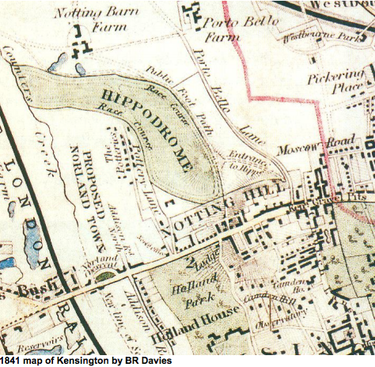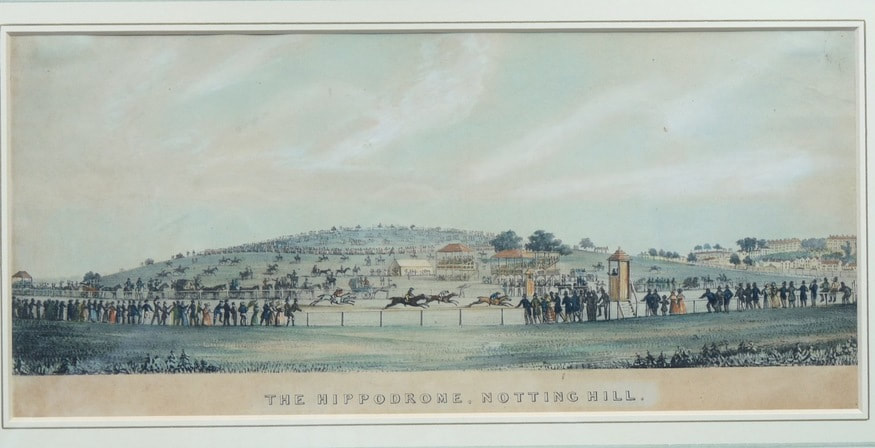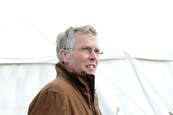|
The inhabitants of north London have been poorly served by racecourses within easy reach until Chelmsford was created under the name Great Leighs in 2008. Anyone looking for a day's sport would have to travel north to Newmarket or Huntingdon for their entertainment, or to the west and south of London. Yet London, and Hertfordshire especially, has always enjoyed a vibrant racing scene. In the height of the Victorian era, before the urban sprawl of London absorbed much of outer London, there were dozens of racecourses. As in some rare countries of the world now, like Mauritius, racing was the leading sport, surpassing sports like football and rugby, which didn't categorize their rules until the early 1860s. Inner city racecourses, like the Kensington Hippodrome, in Notting Hill, west London, allowed the growing population of working class industrial London to enjoy the Sport of Kings close up. But generally speaking, the racecourses were further out of town, where suburbanization had not yet spread so dramatically that hunting had ceased. There were race meetings held consistently at venues like Northolt Park, Egham, Croydon, Harrow, and Hertfordshire was a hotbed of entrepreneurs, eager to stage an event where money could be made and the finest sport enjoyed. In this series of articles focused on London's former courses, the details of some nineteenth century events are somewhat sketchy, but here are a few to savour.  Kensington Hippodrome The racecourse stood on what is now one of London's most fashionable areas. In the late C18th, the Ladbroke Estate, spanning from western Bayswater nearly to Holland Park and down the hill toward the bottom of Ladbroke Grove (scene of the famous Notting Hill movie) was owned by a Richard Ladbroke, of Surrey. When he died childless, the estate passed to his nephew James, who saw plenty of development opportunity around the growth of housing in London. Through a private act of Parliament, he was able to traduce his uncle's express wish for leases only to extend to 21 years, and began a development programme based on 99 year leases, much of which remains today in the leafy streets, crescents and squares of the area, where I was fortunate enough to grow up. But sadly for James, the housing boom petered out in the twenties, so that when entrepreneur John Whyte offered to lease a large tract of land to create a racecourse in 1837, he was welcomed with open arms. His prospectus for the course reads as follows," An extensive range of land, in a secluded situation, has been taken and thrown into one great park,and is being fenced in all around by a strong high paling. This park affords the facility of a steeplechase course,intersected by banks and every description of fence; and also a racecourse distinct from the steeplechase course; and each capable of being suited to a 4 mile race for horses of the first class." There was little doubting Whyte's ambition to rival Epsom and Ascot right in the western end of London. The site between St John's Church and Ladbroke Square gardens would serve as a natural grandstand to view the races. The Sporting Magazine, self-evidently well-lavished with backhanders to give good reviews, wrote as follows," Entering, I was by no means prepared for what opened upon me. Here, without figure of speech was the most perfect race-course that I had ever seen. Conceive, almost within the bills of mortality, an enclosure some 2 miles and a half in circuit, commanding from its centre a view as spacious and enchanting as that from Richmond Hill, and where almost the only thing that you can not see is London. "Around this, on the extreme circle, next to the lofty fence by which it is protected… is constructed, or rather laid out – for the leaps are natural fences – the steeplechase course of 2 miles and a quarter. Within this, divided by a slight trench, and from the space appropriated to carriages and equestrians by strong and handsome posts all the way round, is the race-course, less probably than a furlong in circuit. "Then comes the enclosure for those who ride or drive as aforesaid; and lastly, the middle, occupied by a hill, from which every yard of the running is commanded, besides miles of country on every side beyond it, and exclusively reserved for foot people. "‘I could hardly credit what I saw. Here was, almost at our doors, a racing emporium more extensive and attractive than Ascot or Epsom, with 10 times the accommodation of either, and where the carriages are charged for admission at three quarters’ less. This great national undertaking is the sole result of individual enterprise, being effected by the industry and liberality of a gentleman by the name of Whyte... "This is an enterprise which must prosper; it is without competitor, and it is open to the fertilisation of many sources of profit." With such a glowing review, how could such a racecourse stumble? The first fixture took place on June 3 1837 to much fanfare, the hills being covered by marquees promising all the fun of the fair alongside the races. All this despite considerable opposition from local people of every strata of society. And the worm was to turn very quickly. Not all reviews were favourable; in one the horses were described as ‘animated dogs’ meat’, in another, ‘save Hokey Pokey, there was nothing that could climb or hobble, much more leap over a hedge, and as to hurdle, it was absurd to attempt one.’ There was also a crowd invasion through a hole in the fence. Illustrating the age old problem of policing the Notting Hill Carnival, on the morning of the first meeting locals cut the hole through the paling, with hatchets and saws, where it blocked the path to Notting Barns farm (at the junction of Ladbroke Grove and Ladbroke Square). Of the 12 to 14,000 who attended, several thousand were freeloaders. Plus ca change, eh? The hole in the fence came about through local people protesting that a public right of way had been blocked, even though the footpath led nowhere in particular. And what seems such a minor issue blew up into a massive controversy. The location of the footpath also brought the great and good of London, dressed in their finery, into direct conflict with the working classes where otherwise they might have been separated. Imagine a silver ring clientele in the Royal Enclosure to make a modern-day comparison. After the death of William III forced the abandonment of the third fixture, the argument continued to rage through the early years of Victoria's reign. Whyte's reputation took a poor turn when he was unable to control unlicensed drinking establishments popping up, and there were reports of children betting, all of which did little to quell local opinion. The footpath issue was finally resolved, being fenced outside the curtilage of the racecourse, which was moved to a more northerly position, but other problems manifested themselves. The clay soil made training on the site impossible for much of the winter, and meetings were avoided by the top riders of the day like Gem Mason. In 1841 there were two more fixtures, featuring the grandly named Hyde Park Derby, the Notting Hill Stakes and Kensington Free Plate. But after the June two day meeting, John Whyte admitted defeat. He'd managed to run just 13 race days in five years. He relinquished the lease, in time for James Ladbroke to continue his building programme in partnership with architect Thomas Allison. Yet whilst there is little sign of the racecourse other than in the occasional street name, the configuration of the building designs owes much to the layout of the racecourse. Visit Portland Road now to visualize the home straight of the course. And it didn't need a film with A-lister stars like Julia Roberts and Hugh Grant to allow houses in the area to grow monster prices that have made Notting Hill one of the most sought-after areas of London. Racecourses disappearing under the bulldozer? Maybe not just a twentieth century phenomenon.
Comments are closed.
Northaw Racing NewsWelcome to the News page. Here you will find the very latest information about Northaw Races and race course conditions
If you'd like to submit content to this site, please email here for details Archives
May 2024
Categories |




 RSS Feed
RSS Feed